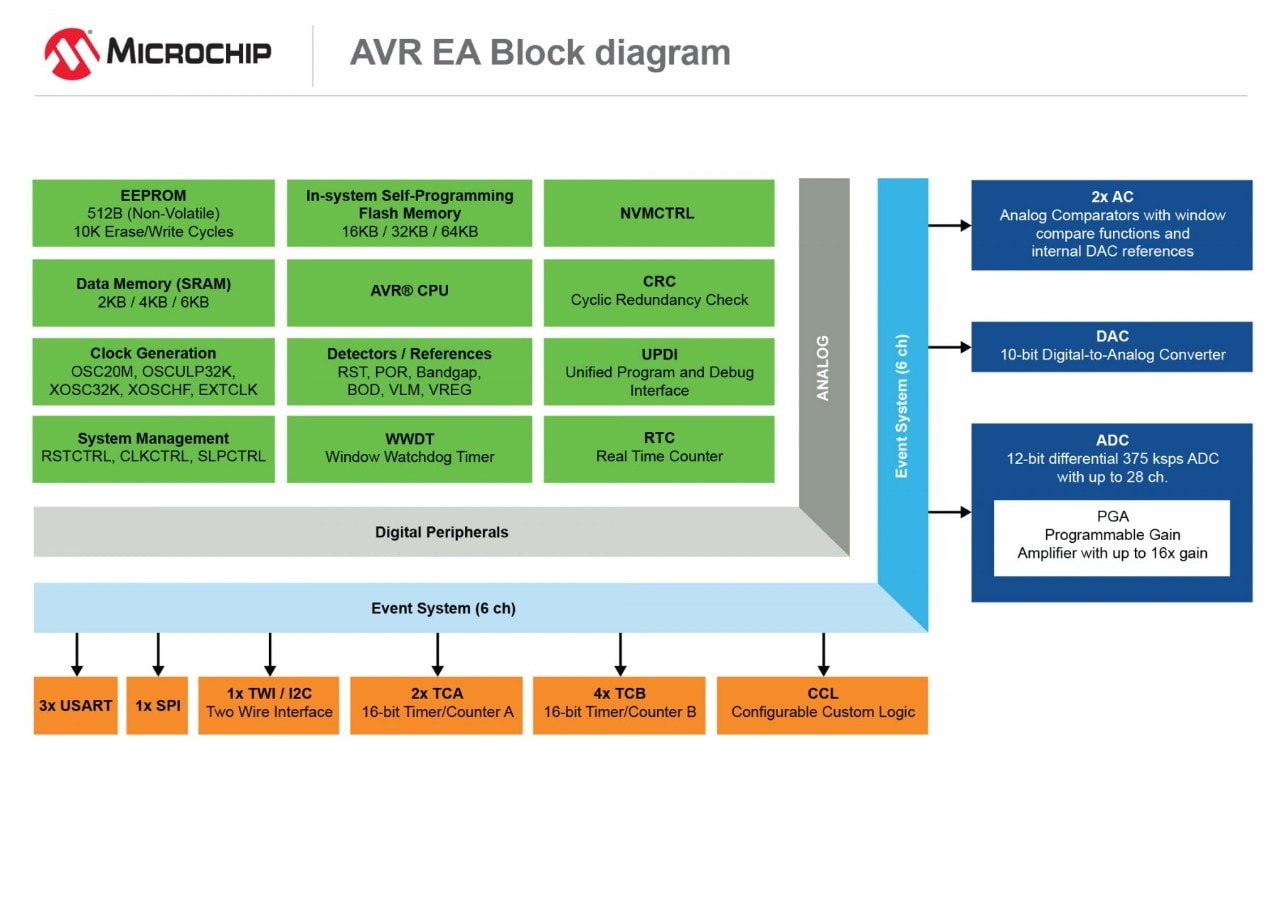Advanced Analog Sensing Made Simple
We equipped the AVR EA family of microcontrollers (MCUs) with high-speed integrated analog, hardware-based Core Independent Peripherals (CIPs) and low-power performance for efficient real-time control, sensor node and secondary safety monitoring applications.
For design flexibility and to optimize your board layout, we offer this family of 16 KB to 64 KB Flash devices in SPDIP, SSOP, TQFP and VQFN packages ranging from 28 to 48 pins. These AVR EA MCUs are well suited for a wide range of industrial, consumer, appliance, automotive, sensor node and other applications. The AVR EA family of MCUs is a great option for closed-loop control system designs and secondary monitoring devices for safety reasons.

Enabling Reliable Sensor Interfaces in Harsh Environments
Getting Started
The AVR64EA48 Curiosity Nano board is the best platform for rapid prototyping with the EA Family of MCUs. This USB-powered kit features an on-board programmer/debugger that seamlessly integrates with MPLAB® X, Microchip Studio and IAR Embedded Workbench for AVR® Integrated Development Environments (IDEs). Its small form factor makes it excellent for breadboard soldering, or you can combine it with the Curiosity Nano Base for Click boards™, which features multiple mikroBUS™ sockets so you can easily add sensors, actuators or communications interfaces from Mikroelektronika’s extensive selection of Click boards.
- MPLAB X IDE Projects
- Training Videos (Six episodes on getting started with the 12-bit differential ADC and PGA)

Functional Safety Ready for Safety-Critical Applications
Our AVR EA family for safety-critical applications targets both industrial and automotive products. We also offer the MPLAB XC8 Functional Safety Compiler License, which is a TÜV SÜD-certified compiler package that supports 8-bit PIC® and AVR MCUs. Our AVR EA ISO 26262 and IEC 61508 functional safety packages come with documents such as FMEDA reports and safety manuals.
System Features
Real-Time Response
Event System
The Event System allows peripherals to communicate directly with each other without involving the CPU or bus resources. This means that different triggers at the peripheral level can result in an event, such as a timer’s interrupts triggering an action in another peripheral. The Event System has three independent channels for direct peripheral-to-peripheral signaling. This deterministic signaling method is a perfect fit for real-time applications. The events are handled at the peripheral level even if the CPU is occupied handling interrupts or in sleep mode.
Safety First
CRC, WWDT, BOD, POR, VLM, CFD
You can use the built-in features that support safety-critical applications to add robustness and reliability to your design. These include the Windowed Watchdog Timer (WWDT) for system supervision, the Cyclic Redundancy Check (CRC) for scanning Flash memory, and the Event System for fault detection. Other features include a Voltage Level Monitor (VLM), a Brown-Out Detector (BOD) and Power-On Reset (POR) for monitoring the supply voltage. The CFD enables the microcontroller to detect if the primary clock source stops and then automatically switch over to an alternative internal clock source.
Hardware Customization
Configurable Custom Logic
The Configurable Custom Logic (CCL) peripheral is a programmable logic peripheral that can be connected to the device pins, events or other internal peripherals. Each Lookup Table (LUT) consists of three inputs: a truth table, an optional synchronizer and a filter and edge detector. An LUT can generate an output to be routed internally or to an I/O pin. This eliminates the need for external logic and reduces BOM cost.
Integrated Analog
12-bit differential ADC with PGA, 10-bit DAC, Analog Comparator
The on-board 12-bit, 375 ksps differential Analog-to-Digital Converter (ADC) features selectable internal voltage references with minimal temperature drift, and Programmable Gain Amplifier (PGA) supporting up to 16x gain making it possible to retrieve small signals in noisy environments. Using the Event System, the on-board Analog Comparator (AC) can be connected to trigger autonomous operation in other peripherals, which is ideal for real-time control and closed-loop operations. The output of the 10-bit Digital-to-Analog Converter (DAC) can either be sent to a pin or it can be used to generate an adjustable reference voltage for the AC.
Power-Conserving Functionality
Idle, Standby, Power-Down
Idle and Standby low-power modes allow you to optimize your application for device performance and power consumption. The Power-Down allows unused peripherals to be turned off individually, further reducing power consumption.
